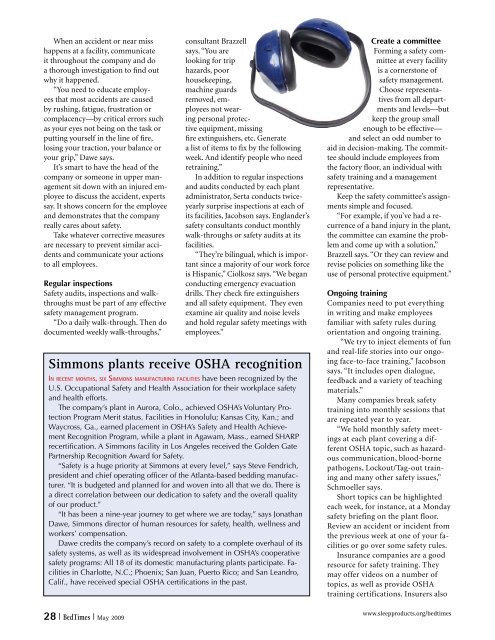Create successful ePaper yourself
Turn your PDF publications into a flip-book with our unique Google optimized e-Paper software.
When an accident or near miss<br />
happens at a facility, communicate<br />
it throughout the company and do<br />
a thorough investigation to find out<br />
why it happened.<br />
“You need to educate employees<br />
that most accidents are caused<br />
by rushing, fatigue, frustration or<br />
complacency—by critical errors such<br />
as your eyes not being on the task or<br />
putting yourself in the line of fire,<br />
losing your traction, your balance or<br />
your grip,” Dawe says.<br />
It’s smart to have the head of the<br />
company or someone in upper management<br />
sit down with an injured employee<br />
to discuss the accident, experts<br />
say. It shows concern for the employee<br />
and demonstrates that the company<br />
really cares about safety.<br />
Take whatever corrective measures<br />
are necessary to prevent similar accidents<br />
and communicate your actions<br />
to all employees.<br />
Regular inspections<br />
Safety audits, inspections and walkthroughs<br />
must be part of any effective<br />
safety management program.<br />
“Do a daily walk-through. Then do<br />
documented weekly walk-throughs,”<br />
28 | <strong>BedTimes</strong> | May 2009<br />
consultant Brazzell<br />
says. “You are<br />
looking for trip<br />
hazards, poor<br />
housekeeping,<br />
machine guards<br />
removed, employees<br />
not wearing<br />
personal protective<br />
equipment, missing<br />
fire extinguishers, etc. Generate<br />
a list of items to fix by the following<br />
week. And identify people who need<br />
retraining.”<br />
In addition to regular inspections<br />
and audits conducted by each plant<br />
administrator, Serta conducts twiceyearly<br />
surprise inspections at each of<br />
its facilities, Jacobson says. Englander’s<br />
safety consultants conduct monthly<br />
walk-throughs or safety audits at its<br />
facilities.<br />
“They’re bilingual, which is important<br />
since a majority of our work force<br />
is Hispanic,” Ciolkosz says. “We began<br />
conducting emergency evacuation<br />
drills. They check fire extinguishers<br />
and all safety equipment. They even<br />
examine air quality and noise levels<br />
and hold regular safety meetings with<br />
employees.”<br />
Simmons plants receive OSHA recognition<br />
In recent m o n t h s, sIx sIm m o n s m A n u f A c t u r I n g fAcIlItIes have been recognized by the<br />
U.S. Occupational Safety and Health Association for their workplace safety<br />
and health efforts.<br />
The company’s plant in Aurora, Colo., achieved OSHA’s Voluntary Protection<br />
Program Merit status. Facilities in Honolulu; Kansas City, Kan.; and<br />
Waycross, Ga., earned placement in OSHA’s Safety and Health Achievement<br />
Recognition Program, while a plant in Agawam, Mass., earned SHARP<br />
recertification. A Simmons facility in Los Angeles received the Golden Gate<br />
Partnership Recognition Award for Safety.<br />
“Safety is a huge priority at Simmons at every level,” says Steve Fendrich,<br />
president and chief operating officer of the Atlanta-based bedding manufacturer.<br />
“It is budgeted and planned for and woven into all that we do. There is<br />
a direct correlation between our dedication to safety and the overall quality<br />
of our product.”<br />
“It has been a nine-year journey to get where we are today,” says Jonathan<br />
Dawe, Simmons director of human resources for safety, health, wellness and<br />
workers’ compensation.<br />
Dawe credits the company’s record on safety to a complete overhaul of its<br />
safety systems, as well as its widespread involvement in OSHA’s cooperative<br />
safety programs: All 18 of its domestic manufacturing plants participate. Facilities<br />
in Charlotte, N.C.; Phoenix; San Juan, Puerto Rico; and San Leandro,<br />
Calif., have received special OSHA certifications in the past.<br />
Create a committee<br />
Forming a safety committee<br />
at every facility<br />
is a cornerstone of<br />
safety management.<br />
Choose representatives<br />
from all departments<br />
and levels—but<br />
keep the group small<br />
enough to be effective—<br />
and select an odd number to<br />
aid in decision-making. The committee<br />
should include employees from<br />
the factory floor, an individual with<br />
safety training and a management<br />
representative.<br />
Keep the safety committee’s assignments<br />
simple and focused.<br />
“For example, if you’ve had a recurrence<br />
of a hand injury in the plant,<br />
the committee can examine the problem<br />
and come up with a solution,”<br />
Brazzell says. “Or they can review and<br />
revise policies on something like the<br />
use of personal protective equipment.”<br />
Ongoing training<br />
Companies need to put everything<br />
in writing and make employees<br />
familiar with safety rules during<br />
orientation and ongoing training.<br />
“We try to inject elements of fun<br />
and real-life stories into our ongoing<br />
face-to-face training,” Jacobson<br />
says. “It includes open dialogue,<br />
feedback and a variety of teaching<br />
materials.”<br />
Many companies break safety<br />
training into monthly sessions that<br />
are repeated year to year.<br />
“We hold monthly safety meetings<br />
at each plant covering a different<br />
OSHA topic, such as hazardous<br />
communication, blood-borne<br />
pathogens, Lockout/Tag-out training<br />
and many other safety issues,”<br />
Schmoeller says.<br />
Short topics can be highlighted<br />
each week, for instance, at a Monday<br />
safety briefing on the plant floor.<br />
Review an accident or incident from<br />
the previous week at one of your facilities<br />
or go over some safety rules.<br />
Insurance companies are a good<br />
resource for safety training. They<br />
may offer videos on a number of<br />
topics, as well as provide OSHA<br />
training certifications. Insurers also<br />
www.sleepproducts.org/bedtimes
















